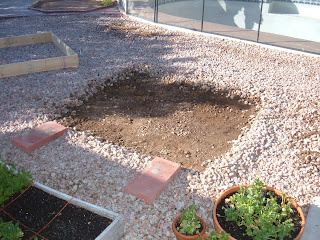I believe that I have fully recovered from being a former garden-hater (see the “About This Blog” page for the full story). I can only laugh at myself as I sit here at my computer and put together a post about starting a garden.
My first major step toward garden-hating recovery took place two years after I had married and moved to Arizona. My husband and I had made plans to spend the entire summer in Washington/Idaho with my family. I called my mom on the phone and emphatically insisted that she wait until I got there to plant her garden, because I wanted to help. I’m not sure if she passed out or became light-headed, because she never revealed her physical reaction to my demand.
It wasn’t until years later that my husband and I finally bought our first house and lived in a structure other than an apartment or condo. We had so much space in our backyard that was not being used that the thought occurred to me that I could plant my own garden. But gardening in Arizona and gardening in the Pacific Northwest are two different things!
Can I plant in this soil that has the consistency of concrete? What can I plant? When do I plant it? Can I grow throughout the torturous summer heat? Can I grow through the winter, even if it freezes for a few nights? I had so many questions and virtually no answers.
My garden-loving mother bought me a book that got me started in the right direction: “All New Square-Foot Gardening” by Mel Batholomew.
This book taught me the how-to of creating above-ground garden beds, how to grow far more in the square-foot method compared to the straight row method, and how to grow vertically in a raised bed.
The best resource for those who do live in the Sonoran Desert is the Mary Irish book, “Gardening in the Deserts of Arizona”.
This book gives great detail about what to do with your garden, flowers, lawn, and trees each month of the year.
With the knowledge from these two books, I finally had the courage to give desert gardening a try. I began with one 4’x4’ bed. A year later, I added a second bed. This year I have added two more beds. This gives me a combined total of 64 sq. ft. of garden space.
Once you’ve selected the location for your garden bed, you will want to prepare the ground. My yard is full of granite, so I had to shovel it up to make way for my garden.
Next, I placed a layer of weed cloth on the ground and placed my wooden frame over it. I have used 1”x6” pieces of lumber, screwed together at the ends.
I combined my soil on the patio, but if you don’t have a patio near your garden, I recommend that you use a tarp so you don’t lose your soil to the lawn.
Mel’s mix calls for 1/3 peat moss, 1/3 vermiculite, and 1/3 other soil products, such as manure, compost, etc. My first two beds were made with this precise mixture. Recently, I have wondered if vermiculite is safe. I’m not sure if it is free of asbestos. It is also difficult to find and is rather pricey. For my two new beds, I have opted out of using vermiculite. Here is what I added to EACH SQUARE:
2 bags of Organic Choice garden soil (3 cubic feet)
2 bags of peat moss (4.4 cubic feet)
2 bags of steer manure (2 cubic feet)
You need about 8 cubic feet of soil to fill your box. Once you’ve combined your “ingredients”, fill up the frame.
To give your garden a tidy appearance and to aid in the square foot method, you will need to use small wooden dividers to section your 4’x4’ square into sixteen 1’x1’ squares. I went the frugal route and used yarn. I hammered nails into the frame and wrapped yarn around them. It works just as well and can easily be removed once your plants begin to grow, although I like to leave mine.
You are now ready to plant. Find out the recommended planting times for various vegetables, flowers or herbs. I water by hand with a hose that has a shower attachment at the end. As for weeding, I do that… RARELY! With this method, I rarely have weeds.
It is truly amazing how much you can grow in one 4’x4’ square. This winter, I harvested the following:
54 beets
64 carrots
8 spinach plants
32 radishes
I also turned one entire box into a strawberry patch. It began with a very small plant, but it has spread to fill over half the box already.
These raised garden beds can be used on a patio or a rooftop as well. Some who are physically unable to get down to the ground to garden can have their box built on legs where they can stand or sit to work in it.
What are you waiting for? Get your garden beds ready and choose your seeds. We’ll talk more about seeds in the next post.








No comments:
Post a Comment